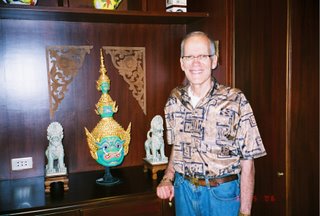Tarin Plays “Hummingbird” (Name of Bosendorfer Piano Used)
 |
| Thai pianist Tarin Supprakorn following his successful Bangkok recital. |
Siam Music Yamaha
Concert Salon. Bangkok, Thailand. July 6, 2013.
There are a small, but not tiny, number of highly talented Thai
piano students whom I’ve been following since their early teenage years. It was easy for me to do this because there
are many opportunities for them to play in public in local competitions,
festivals, and events sponsored by their teachers and others, which gives them
an early chance to get used to practicing for and performing in front of the public,
as well as affording me the chance to listen to many hours of music from young
souls, absent the concern of a parent.
These successful budding pianists have followed more or less the same
path to their current ages of about 22:
thorough study with one of Bangkok’s very good teachers, a transfer to
Singapore’s excellent music conservatory, which has a connection with Peabody
Conservatory, and then on to Europe or the United States to become degree
candidates in some of the world’s best music schools, e.g., Eastman, Peabody,
RCM. But of course, the vagaries of
growing up (and life itself) are such that one can never predict how any
teenager will turn out.
Well, when it comes to Tarin Supprakorn, whom I first heard
play when he was about 14, the evidence is in:
he’s terrific. At age 22, in
Bangkok on July 6, Tarin presented a recital program which would have been the
envy of many professional pianists. He
declined to play anything easy---the Bach and Mozart are not exceptions---and
structured his recital to reflect some of the major components of classical
piano playing: baroque (Fantasia and Fugue in A minor of Bach); classical
(Sonata No. 9 by Mozart), 20th century impressionism (Debussy
etudes), and romanticism (Schumann’s Carnaval).
Tarin showed not only that he can play anything he wants to play, but
also that he plays everything well.
When I studied plane geometry, there was an axiom I learned
early on: the whole equals the sum of
its parts. While you can’t do geometry
without taking it to heart, the same axiom is a disaster in such monumental
works as Schumann’s Carnaval, which is made up of 22 quite short
miniatures. The trick to playing
Carnaval is to make sure that the performance equals more than the total of its
22 disparate parts. This is known as
transcendence, or simply, making beautiful music. The look of absorption and concentration on
Tarin’s face as he played this fiendishly difficult and long piece, disclosed that
something very profound was going on inside, but one doesn’t have to have an
x-ray to know what that was: the depths
of Schumann were being mined, nurtured, examined, loved and cherished. It is a testament to Tarin’s artistry that he
was able to communicate all of this to his listeners. Tarin is returning to Eastman for graduate
studies in piano performance. If he
keeps up like this (and I don’t doubt that he will) he will soon be teaching
his teachers.



0 Comments:
Post a Comment
<< Home